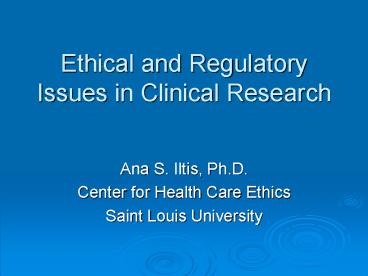Ethical and Regulatory Issues in Clinical Research - PowerPoint PPT Presentation
1 / 24
Title:
Ethical and Regulatory Issues in Clinical Research
Description:
Center for Health Care Ethics. Saint Louis University. What is Research ' ... Ethics. Interpretation and application of regulations. Guide actions when ... – PowerPoint PPT presentation
Number of Views:771
Avg rating:3.0/5.0
Title: Ethical and Regulatory Issues in Clinical Research
1
Ethical and Regulatory Issues in Clinical
Research
- Ana S. Iltis, Ph.D.
- Center for Health Care Ethics
- Saint Louis University
2
What is Research
- Systematic investigation designed to develop or
contribute to generalizable knowledge
(45CFR46.102.d) - Gray zones
- QA/QI
- Innovative practices
- Case Reports
3
Compliance and Ethics
- Compliance
- Regulations
- Minimum standards
- Ethics
- Interpretation and application of regulations
- Guide actions when regulations are silent
- Responsible Conduct of Research (RCR)
4
Compliance Regulatory Structures
- Federal regulations
- State regulations
- Courts
- Institutions
5
Compliance Federal Regulations
- Common Rule 45CFR46
- OHRP guidance
- FDA 21CFR50 and 21CFR56
- www.fda.gov/oc/bcp/comparison.html
- HIPAA
6
Compliance State Government
- Examples
- New York and Virginia all research subject to
protections comparable to the Common Rule - California all research subject to informed
consent requirements comparable to the Common Rule
7
Compliance Courts
- Examples
- Kennedy Krieger (Maryland court)
- Tampa General Hospital (Federal court)
8
Compliance Institutions
- Institutional rules and processes
- IRB/HRPO
9
Ethics
- Sources
- Guidance documents
- Professional literature
- Deliberation/Analysis
- Relationship to compliance
- National Commission for the Protection of Human
Subjects of Biomedical and Behavioral Research
10
Guidance Documents
- Nuremberg Code
- Declaration of Helsinki (World Med. Assn.)
- International Ethical Guidelines for Biomedical
Research Involving Human Subjects (CIOMS w/ WHO) - Guidelines for Good Clinical Practice for Trials
on Pharmaceutical Products (WHO) - Good Clinical Practice Consolidated Guidance
(ICH)
11
Ethical Principles
- Belmont Report
- Respect for Persons autonomy, informed consent,
and protection of the vulnerable - Beneficence benefits exceed risk minimize risk
- Justice fairly distribute benefits and burdens
fair subject selection research population
expected to benefit
12
Ethical Principles
- Emanuel et al (JAMA, 283(20) 2701-2711)
- Social or scientific value
- Scientific validity
- Fair subject selection
- Favorable risk-benefit ratio
- Independent review
- Informed consent
- Respect for potential and enrolled subjects
13
Importance of Ethical Deliberation
- Regulatory silence or ambiguity
- Ethical principles and guidance require
application
14
Making Ethical Decisions
- Two types of ethical quandaries
- Ambiguity
- Disagreement
- Norms/Values/Principles
- Goals, duties, and ideals that ought to guide
actions (see Belmont and Emanuel et al) - Decision making tools or frameworks
- Translate abstract concepts into action
- Resolve conflicts
- SFNO
15
Ethical Deliberation and Case Analysis SFNO
Framework
- 1. Identify the problem or concern.
- 2. Identify the stakeholders and key players.
- 3. Identify the facts.
- 4. Identify the relevant norms, values, and
goals. - 5. Identify and analyze options.
- 6. Recommend and justify an option.
16
1. Identify the Problem
- Is there a conflict? Is there a need for
clarification? Is there genuine uncertainty? - What triggered the problem or concern?
- Is this a new problem or the first time the
problem has been identified? Is this a recurring
issue? - Does the problem involve ethical issues?
17
2. Identify the Stakeholders
- Parties (persons and institutions or
organizations) who may have a legitimate interest
in a case. - Potential stakeholders include patient, legal
surrogates, family, health care
professionals/investigators, health care
facilities, other patients, third party payers,
research sponsors, society - Identify the nature of each stakeholders
interest - What special features are relevant to a
stakeholder, e.g., decision-making authority or
special responsibility?
18
3. Identify the Facts
- Medical facts e.g., diagnosis, prognosis,
alternatives - Legal/Social facts, e.g., decision making
authority and capacity, standards of practice - Patient/Subject/Main Party facts e.g., decision
making capacity, evidence of goals and
preferences - Other facts, e.g., how urgent is it that the
situation be resolved? - Unknown facts or facts in dispute
19
4. Identify the Norms
- Belmont Report
- Emanuel et al
- Other norms, values or principles relevant to a
particular case
20
5. Identify and Analyze Options
- What options exist?
- Do any available options bypass the current
conflict? - Articulate the desired goal
- Evaluate options
- What are the implications of different options
for different stakeholders and norms?
21
6. Recommend and Justify an Option
- Recommend an option
- Determine whether the recommendation is justified
(see next slide) - Determine how the recommended option is to be
implemented or to whom it must be recommended
22
Is The Recommended Option Justified? 5 Critical
Questions
- Effectiveness Will the recommended action be
effective in achieving the desired goal? - Necessity To achieve the desired goal, is it
necessary to pursue the recommended action or is
there an alternative that does not infringe on
competing values? - See Childress, J. et al. (2002). Public Health
Ethics Mapping the Terrain. Journal of Law,
Medicine, and Ethics 30(2) 170-178.
23
Proportionality Is the desired goal sufficiently
important to justify overriding other norms,
principles, or values? Least infringement Does
the recommended option minimize infringement of
competing interests or values? Transparency
Was the decision reached in a procedurally fair
and appropriate way? Could you defend the
decision and the decision-making procedure
publicly?
24
Case Discussion































